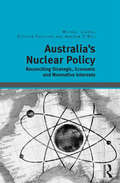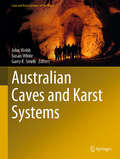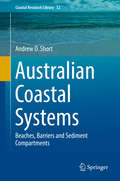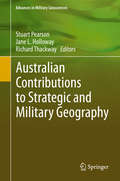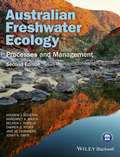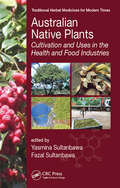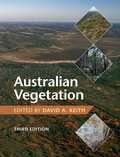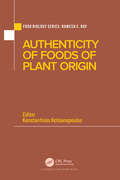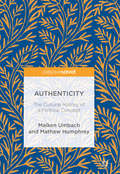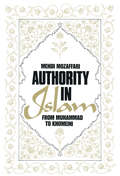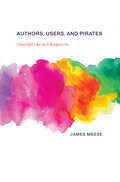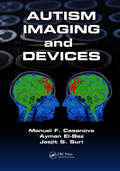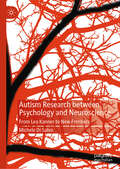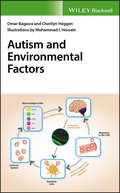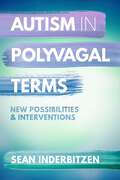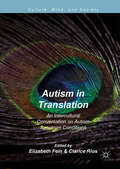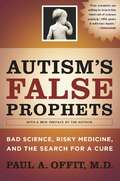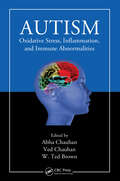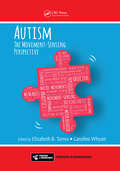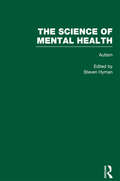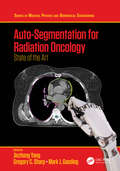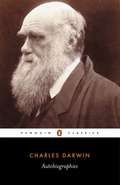- Table View
- List View
Australia's Nuclear Policy: Reconciling Strategic, Economic and Normative Interests
by Michael Clarke Stephan FrühlingAustralia’s Nuclear Policy: Reconciling Strategic, Economic and Normative Interests critically re-evaluates Australia’s engagement with nuclear weapons, nuclear power and the nuclear fuel cycle since the dawn of the nuclear age. The authors develop a holistic conception of ’nuclear policy’ that extends across the three distinct but related spheres - strategic, economic and normative - that have arisen from the basic ’dual-use’ dilemma of nuclear technology. Existing scholarship on Australia’s nuclear policy has generally grappled with each of these spheres in isolation. In a fresh evaluation of the field, the authors investigate the broader aims of Australian nuclear policy and detail how successive Australian governments have engaged with nuclear issues since 1945. Through its holistic approach, the book demonstrates the logic of seemingly conflicting policy positions at the heart of Australian nuclear policy, including simultaneous reliance on US extended deterrence and the pursuit of nuclear disarmament. Such apparent contradictions highlight the complex relationships between different ends and means of nuclear policy. How successive Australian governments of different political shades have attempted to reconcile these in their nuclear policy over time is a central part of the history and future of Australia’s engagement with the nuclear fuel cycle.
Australian Battalion Commanders In The Second World War
by Garth PrattenThis book explores the background, role and conduct of the commanding officers of Australian infantry battalions in World War II.
Australian Caves and Karst Systems (Cave and Karst Systems of the World)
by Susan White John Webb Garry K. SmithThis book, part of the series Cave and Karst Systems of the World, begins with a review of the interaction between people and caves in Australia (including conservation), followed by descriptions of the spectacular cave diving sites, before comprehensively covering all the major carbonate and noncarbonate karst areas, subdivided by rock type and region, and including the origin of the caves. This is followed by broad overviews of cave minerals and speleothems, cave biology and cave fossils. Each section was written by one or more specialists in the topic and is illustrated by clear diagrams and superb colour photos. The book emphasises the unique aspects of the Australian karst, including the variability in the age of the caves (very old to very young) and the impact of isolation on the stygofauna, as well as the vertebrate fossils preserved in the caves. Written in an easy-to-read style, the book is a primary reference guide to Australian karst and represents a valuable asset for anyone interested in the topic, not only cavers and academics.
Australian Coastal Systems: Beaches, Barriers and Sediment Compartments (Coastal Research Library #32)
by Andrew D. ShortThis book describes the entire coast and beaches and barrier systems of Australia. It covers the coastal processes and systems that form and impact Australia's 30.000 km coast, 12.000 beaches and 2750 barrier systems. These processes include geology, geomorphology, climate, waves, tides, currents, sediment supply, as well as coastal ecosystems. The coast is divided into tropical northern and southern temperate provinces, within which are seven divisions, 23 regions and 354 coastal sediment compartments each of which is described in detail in the 34 chapters. Within these systems are the full range of wave through tide-dominated beaches and barriers ranging from cheniers to massive transgressive dune systems together with a range of onshore and longshore sand transport systems. This is an up to date reference for the entire coast, its present condition and likely responses to the impacts of climate change.
Australian Contributions to Strategic and Military Geography (Advances In Military Geosciences Ser.)
by Stuart Pearson Jane L. Holloway Richard ThackwayDrawing from military geography’s spatial roots, its embrace of dynamic systems, and integration of human and biophysical environments, this book helps in understanding the value of analyzing patterns, processes and systems, and cross-scale and multi-disciplinary ways of acting in a complex world, while making the case for a resurgence of strategic and military geography in Australia. Here, leading experts demonstrate that geography retains its relevance in clarifying the scale and dynamics of defense activities in assessments of the international, regional, national, and site impacts of changes in physical, cyber and human geographies. The cases presented show Australia contributing to a growing strategic and military geography.
Australian Freshwater Ecology: Processes and Management
by Jenny Davis Jane Chambers Darren Ryder Margaret Brock Belinda Robson Andrew BoultonAs pressures on Australia’s inland waters intensify from population growth, expanding resource development and climate change, there is an urgent need to manage and protect these special areas. Understanding their ecology underpins their wise management and conservation. Australian Freshwater Ecology vividly describes the physical, chemical and biological features of wetlands, lakes, streams, rivers and groundwaters in Australia. It presents the principles of aquatic ecology linked to practical management and conservation, and explains the causes, mechanisms, effects and management of serious environmental problems such as altered water regimes, eutrophication, salinization, acidification and sedimentation of inland waters. Key features: contributions from a diverse, highly qualified team of aquatic ecologists whose expertise spans the ecology and management of standing and running waters in Australia sections covering groundwaters, biodiversity, temporary and tropical waters, climate change, invasive species and freshwater conservation numerous Australian case-studies and guest ‘text-boxes’ showing management in practice concise descriptions of ecological processes and conceptual models illustrated with original, high- quality diagrams and photographs Readable and logically structured, this text supports undergraduate and postgraduate courses in aquatic ecology and management. It is a valuable reference for consultants, restoration ecologists, water resource managers, science teachers, and other professionals with an interest in the ecology of surface and groundwaters.
Australian Native Plants: Cultivation and Uses in the Health and Food Industries (Traditional Herbal Medicines for Modern Times)
by Yasmina Sultanbawa and Fazal SultanbawaAustralian Native Plants: Cultivation and Uses in the Health and Food Industries provides a comprehensive overview of native food crops commercially grown in Australia that possess nutritional and health properties largely unknown on a global basis. These native foods have been consumed traditionally, have a unique flavor diversity, offer significant health promoting effects, and contain useful functional properties. Australian native plant foods have also been identified for their promising antioxidant and antimicrobial properties that have considerable commercial potential. This book is divided into three parts: The first part reviews the cultivation and production of many Australian native plants (ANP), including Anise Myrtle, Bush Tomato, Desert Raisin, Davidson’s Plum, Desert Limes, Australian Finger Lime, Kakadu Plum, Lemon Aspen, Lemon Myrtle, Muntries, Native Pepper, Quandong, Riberry, and Wattle Seed. It then examines the food and health applications of ANP and discusses alternative medicines based on aboriginal traditional knowledge and culture, nutritional characteristics, and bioactive compounds in ANP. In addition, it reviews the anti-obesity and anti-inflammatory properties of ANP and discusses food preservation, antimicrobial activity of ANP, and unique flavors from Australian native plants. The third section covers the commercial applications of ANP. It focuses on native Australian plant extracts and cosmetic applications, processing of native plant foods and ingredients, quality changes during packaging, and storage of Australian native herbs. The final few chapters look into the importance of value chains that connect producers and consumers of native plant foods, new market opportunities for Australian indigenous food plants, and the safety of using native foods as ingredients in the health and food sectors.
Australian Vegetation
by David A. KeithAustralian Vegetation has been an essential reference for students and researchers in botany, ecology and natural resource management for over 35 years. Now fully updated and with a new team of authors, the third edition presents the latest insights on the patterns and processes that shaped the vegetation of Australia. The first part of the book provides a synthesis of ecological processes that influence vegetation traits throughout the continent, using a new classification of vegetation. New chapters examine the influences of climate, soils, fire regimes, herbivores and aboriginal people on vegetation, in addition to completely revised chapters on evolutionary biogeography, quaternary vegetation history and alien plants. The book's second half presents detailed ecological portraits for each major vegetation type and offers data-rich perspectives and comparative analysis presented in tables, graphs, maps and colour illustrations. This authoritative book will inspire readers to learn and explore first-hand the vegetation of Australia.
Authenticity of Foods of Plant Origin (Food Biology Series)
by Konstantinos KotsanopoulosFood is adulterated to increase profit or due to negligence. Adulteration can compromise food safety and quality, and harm consumers. This may undermine consumer trust and the reputation of the food industry. As such, it is very important to monitor, control and detect adulteration. A number of techniques have been developed for the authentication of food and verifying its quality and associated claims. Foods of plant origin are the source of nutrients for billions of people around the globe. Due to the huge variety of plants, and the lack of visual characteristics as a result of processing, advanced techniques are required to detect adulteration. This book reviews the latest developments in the field of authenticity of foods of plant origin, examining concepts such as traceability, and how they are applied to facilitate the support of claims, as well as legislative requirements in the major economies around the world. The basic techniques used nowadays in verifying authenticity of these types of foods are reviewed and discussed, and their applications are summarized. The book also focuses on categories of foods most prone to adulteration attempts due to their characteristics, properties and production methods commonly followed, thus allowing the reader to more easily identify the chapter that is of interest in each case. The book will be of interest to food industrialists, chemists, quality control scientists and technologists, microbiologists, analytical chemists and food physical chemists within the food industry. It is also aimed at academicians who are interested in the authenticity of foods of plant origin and the advancements in the analytical fields that support relevant legal and marketing requirements.
Authenticity: The Cultural History of a Political Concept
by Maiken Umbach Mathew HumphreyAuthenticity is everywhere: political leaders invoke the idea to gain our support, advertisers use it to sell their products. But is authenticity a dangerous hoax? What is, and is not, authentic has been hotly debated ever since the concept was invented. Many academics have sought to "unmask" authenticity claims as deceptive. This book takes a different approach. In chapters covering historical and contemporary examples, the authors explore why authenticity, real or imagined, exercises such a powerful hold on our imaginations. The chapters trace how invocations of authenticity borrow from one another, across arenas such as philosophy and theology, encounters with nature, leisure, and mass consumption, political and corporate leadership, left-wing and right-wing ideologies. This cultural history of authenticity is of interest to academic and lay readers alike, who are interested in the significance and history of a concept that shapes how we understand ourselves and the world we live in.
Authority in Islam: From Mohammed to Khomeini
by Mehdi MozaffariThis text looks at the future orientation of the People's Liberation Army. It covers military leadership, readiness and expenditure, defense doctrine, high-tech warfare acquisitions, the scientific and technological base for defense procurement and China's security concerns in Northeast Asia.
Authors, Users, and Pirates: Copyright Law and Subjectivity (The Information Society Series)
by James MeeseAn examination of subjectivity in copyright law, analyzing authors, users, and pirates through a relational framework.In current debates over copyright law, the author, the user, and the pirate are almost always invoked. Some in the creative industries call for more legal protection for authors; activists and academics promote user rights and user-generated content; and online pirates openly challenge the strict enforcement of copyright law. In this book, James Meese offers a new way to think about these three central subjects of copyright law, proposing a relational framework that encompasses all three. Meese views authors, users, and pirates as interconnected subjects, analyzing them as a relational triad. He argues that addressing the relationships among the three subjects will shed light on how the key conceptual underpinnings of copyright law are justified in practice.Meese presents a series of historical and contemporary examples, from nineteenth-century cases of book abridgement to recent controversies over the reuse of Instagram photos. He not only considers the author, user, and pirate in terms of copyright law, but also explores the experiential element of subjectivity—how people understand and construct their own subjectivity in relation to these three subject positions. Meese maps the emergence of the author, user, and pirate over the first two centuries of copyright's existence; describes how regulation and technological limitations turned people from creators to consumers; considers relational authorship; explores practices in sampling, music licensing, and contemporary art; examines provisions in copyright law for user-generated content; and reimagines the pirate as an innovator.
Autism Imaging and Devices
by Jasjit S. Suri Manuel F. Casanova Ayman El-BazThis book covers state-of-the-art medical image analysis approaches currently pursued in autism research. Chapters cover recent advances in diagnosis using structural neuroimaging. All aspects of imaging are included, such as electrophysiology (EEG, ERP, QEEG, and MEG), postmortem techniques, and advantages and difficulties of depositing/acquiring images in larger databases. The book incorporates 2D, 3D, and 4D imaging and advances scientific research within the broad field of autism imaging.
Autism Research between Psychology and Neuroscience: From Leo Kanner to New Frontiers
by Michele Di SalvoThis book offers an overview of the history, definitions, and treatments for autism spectrum disorders from 1943 to the present day. Bridging the gap between psychology and neuroscience through a rigorous reconstruction of eighty years of research, the author retraces the emergence of the definition of autism and the description of its characteristics, the history of the diagnosis and standardized classification of ASD in the Diagnostic and Statistical Manual of Mental Disorders, and the development of etiological research and therapeutic interventions in medical, psychoeducational, and alternative therapies. The content spans neurology, genetics, psychiatry, and medicine, integrating discoveries from different fields to shed light on relevant factors of the pathology and dynamics of ASD. A useful resource for students and researchers in psychology, psychiatry, special education, and healthcare, this book unveils the latest advances in the field of ASD and discusses the research agenda for the years to come, showcasing multidirectional approaches to improve the quality of life of autistic people.
Autism and Environmental Factors
by Omar Bagasra Cherilyn Heggen Muhammad I. HossainExplores environmental factors during fetal development that may contribute to autism It is well documented that in the majority of the cases, an autistic child's brain has acquired the genetic and organismal abnormalities that were initiated during the first trimester of their gestational period. Yet, scientists still don’t know what is causing these abnormalities; this book explains how the human brain develops and what the critical stages are in which a fetal brain may acquire genetic and developmental abnormalities. It presents scientific data supporting previous anecdotal observations to attempt to understand the complex puzzle that is autism. From chemical fragrances to herbicides, synthetic chemicals are abundant in everyday life and this book examines the evidence surrounding these chemicals and their effects, including on the developing human brain and how that might explain certain characteristics observed in autism. Discussing various aspects of potential ASD causing factors, Autism and Environmental Factors brings together as many pieces of the autism puzzle as possible in one place to begin to clarify the picture and spark discussion to ensure a safe environment for everyone, especially our developing children. Discusses the genetic and environmental factors that may contribute to autism Covers how the human brain develops and the critical stages in which a fetal brain may acquire genetic and developmental abnormalities Describes the rapid proliferation of synthetic chemicals in our modern world and the effects on the developing human brain—endocrine-disturbing chemicals that alter DNA, epigenetics, and hormones Written in a clear and accessible style Autism and Environmental Factors is an important book for researchers and students in neuroscience, neuroanatomy, developmental neurobiology and anyone focusing on autism research.
Autism in Polyvagal Terms: New Possibilities and Interventions (Norton Series on Interpersonal Neurobiology #0)
by Sean M. InderbitzenA vital new framework for working with clients on the spectrum. By presenting the autism diagnosis through the lens of a disordered nervous system—that is, by applying Polyvagal Theory—this book opens new avenues for intervention and treatment, while challenging age-old assumptions of what autism means and how it presents itself. Sean Inderbitzen, an autistic therapist, encourages clinicians to conceptualize their work with autistic clients through a polyvagal lens. Inderbitzen argues that individuals with autism can access their ventral vagal nervous system to promote flexibility and connection to others, and effective polyvagal theory ideas and exercises can help their clients do so. An essential new text for anyone who works clients on the spectrum, this book explores approaches such as motivational interviewing, clinical social work pedagogy, sensorimotor psychotherapy, mindfulness, biofeedback, and cultivating a sense of safety in sessions.
Autism in Translation: An Intercultural Conversation on Autism Spectrum Conditions (Culture, Mind, and Society)
by Clarice Rios Elizabeth FeinAutism is a complex phenomenon that is both individual and social. Showing both robust similarities and intriguing differences across cultural contexts, the autism spectrum raises innumerable questions about self, subjectivity, and society in a globalized world. Yet it is often misrepresented as a problem of broken bodies and disordered brains. So, in 2015, a group of interdisciplinary scholars gathered in Rio de Janeiro, Brazil for an intellectual experiment: a workshop that joined approaches from psychological anthropology to the South American tradition of Collective Health in order to consider autism within social, historical, and political settings. This book is the product of the ongoing conversation emerging from this event. It contains a series of comparative histories of autism policy in Italy, Brazil, and the United States; focuses on issues of voice, narrative, and representation in autism; and examines how the concept of autism shapes both individual lives and broader social and economic systems. Featuring contributions from:Michael BakanBenilton BezerraPamela BlockM. Ariel Cascio Jurandir Freire CostaBárbara Costa AndradaCassandra EvansElizabeth Fein Clara Feldman Roy Richard GrinkerRossano LimaFrancisco OrtegaDawn Prince-HughesClarice Rios Laura Sterponi Thomas S. WeisnerEnrico Valtellina
Autism's False Prophets: Bad Science, Risky Medicine, and the Search for a Cure
by Paul A. OffitA London researcher was the first to assert that the combination measles-mumps-rubella vaccine known as MMR caused autism in children. Following this "discovery," a handful of parents declared that a mercury-containing preservative in several vaccines was responsible for the disease. If mercury caused autism, they reasoned, eliminating it from a child's system should treat the disorder. Consequently, a number of untested alternative therapies arose, and, most tragically, in one such treatment, a doctor injected a five-year-old autistic boy with a chemical in an effort to cleanse him of mercury, which stopped his heart instead. Children with autism have been placed on stringent diets, subjected to high-temperature saunas, bathed in magnetic clay, asked to swallow digestive enzymes and activated charcoal, and injected with various combinations of vitamins, minerals, and acids. Instead of helping, these therapies can hurt those who are most vulnerable, and particularly in the case of autism, they undermine childhood vaccination programs that have saved millions of lives. An overwhelming body of scientific evidence clearly shows that childhood vaccines are safe and does not cause autism. Yet widespread fear of vaccines on the part of parents persists. In this book, Paul A. Offit, a national expert on vaccines, challenges the modern-day false prophets who have so egregiously misled the public and exposes the opportunism of the lawyers, journalists, celebrities, and politicians who support them. Offit recounts the history of autism research and the exploitation of this tragic condition by advocates and zealots. He considers the manipulation of science in the popular media and the courtroom, and he explores why society is susceptible to the bad science and risky therapies put forward by many antivaccination activists.
Autism's False Prophets: Bad Science, Risky Medicine, and the Search for a Cure
by Paul OffitA London researcher was the first to assert that the combination measles-mumps-rubella vaccine known as MMR caused autism in children. Following this "discovery," a handful of parents declared that a mercury-containing preservative in several vaccines was responsible for the disease. If mercury caused autism, they reasoned, eliminating it from a child's system should treat the disorder. Consequently, a number of untested alternative therapies arose, and, most tragically, in one such treatment, a doctor injected a five-year-old autistic boy with a chemical in an effort to cleanse him of mercury, which stopped his heart instead. Children with autism have been placed on stringent diets, subjected to high-temperature saunas, bathed in magnetic clay, asked to swallow digestive enzymes and activated charcoal, and injected with various combinations of vitamins, minerals, and acids. Instead of helping, these therapies can hurt those who are most vulnerable, and particularly in the case of autism, they undermine childhood vaccination programs that have saved millions of lives. An overwhelming body of scientific evidence clearly shows that childhood vaccines are safe and does not cause autism. Yet widespread fear of vaccines on the part of parents persists. In this book, Paul A. Offit, a national expert on vaccines, challenges the modern-day false prophets who have so egregiously misled the public and exposes the opportunism of the lawyers, journalists, celebrities, and politicians who support them. Offit recounts the history of autism research and the exploitation of this tragic condition by advocates and zealots. He considers the manipulation of science in the popular media and the courtroom, and he explores why society is susceptible to the bad science and risky therapies put forward by many antivaccination activists.
Autism: Oxidative Stress, Inflammation, and Immune Abnormalities
by Ted Brown Ved Chauhan Abha ChauhanIn 2007, the Centers for Disease Control and Prevention issued an autism alarm, estimating that one in 150 children may be affected by autism spectrum disorder. Autism has been treated mainly with technical approaches: principally applied behavior analysis and psychopharmacology. The findings in this book implicate oxidative stress as a common feat
Autism: The Movement Sensing Perspective (Foundations and Innovations in Neurobiology)
by Elizabeth B. Torres Caroline WhyattAutism: The Movement Sensing Perspective is the result of a collaborative effort by parents, therapists, clinicians, and researchers from all disciplines in science including physics, engineering, and applied mathematics. This book poses questions regarding the current conceptualization and approach to the study of autism, providing an alternative unifying data-driven framework grounded in physiological factors. This book reaches beyond subjective descriptions of autistic phenomena and embraces a new era of objective measurements, analyses, and statistical inferences. The authors harness activities from the nervous systems across the brain and body (often in tandem), and introduce a platform for the comprehensive personalized phenotyping of individuals with autism. The impact of this approach is discussed to advance the development of tailored treatments options, enhance the ability to longitudinally track symptomatology, and to fundamentally empower affected individuals and their families. This book encompasses a new era for autism research and treatments, and our continuous effort to collectively empower and embrace the autistic community.
Autism: The Science of Mental Health (The Science of Mental Health #2)
by Steven HymanThe Science of Mental Health: Volume 2: Autism by Steven Hyman
Auto-Segmentation for Radiation Oncology: State of the Art (Series in Medical Physics and Biomedical Engineering)
by Jinzhong Yang, Gregory C. Sharp, and Mark J. GoodingThis book provides a comprehensive introduction to current state-of-the-art auto-segmentation approaches used in radiation oncology for auto-delineation of organs-of-risk for thoracic radiation treatment planning. Containing the latest, cutting edge technologies and treatments, it explores deep-learning methods, multi-atlas-based methods, and model-based methods that are currently being developed for clinical radiation oncology applications. Each chapter focuses on a specific aspect of algorithm choices and discusses the impact of the different algorithm modules to the algorithm performance as well as the implementation issues for clinical use (including data curation challenges and auto-contour evaluations). This book is an ideal guide for radiation oncology centers looking to learn more about potential auto-segmentation tools for their clinic in addition to medical physicists commissioning auto-segmentation for clinical use. Features: Up-to-date with the latest technologies in the field Edited by leading authorities in the area, with chapter contributions from subject area specialists All approaches presented in this book are validated using a standard benchmark dataset established by the Thoracic Auto-segmentation Challenge held as an event of the 2017 Annual Meeting of American Association of Physicists in Medicine
Autobiographies
by Charles DarwinThe Autobiographies of Charles Darwin (1809-82) provide a fascinating glimpse into the mind of one of the world's intellectual giants. They begin with engaging memories of his childhood and youth and of his burgeoning scientific curiosity and love of the natural world, which led to him joining the expedition on the Beagle. Darwin follows this with survey of his career and ends with a reckoning of his life's work. Interspersed with these recollections are fascinating portraits - from his devoted wife Emma and his talented father, both bullying and kind, to the leading figures of the Victorian scientific world he counted among his friends, including Lyell and Huxley. Honest and illuminating, these memoirs reveal a man who was isolated by his controversial beliefs and whose towering achievements were attained by a life-long passion for the discoveries of science.
